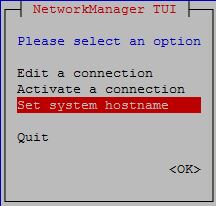To totally unlock this section you need to Log-in
Login
After installing the CentOS 7 on our server, we can try to change host name by modifying the /etc/sysconfig/network; it will probably do not take an effect after the modification.
Even after multiple reboot of server, the host name probably will remain localhost.localdomain (for example). The procedure to change the host name in CentOS 7 is now totally different from the previous version, this guide will help you to setup the host name on CentOS 7 / RHEL 7.
CentOS 7 supports three class of hostnames:
- Static - The static host name is traditional host which can be chosen by the user and is stored in /etc/hostname file.
- Transient - The transient host name is maintained by kernel and can be changed by DHCP and mDNS.
- Pretty - It is a free form UTF-8 host name for the presentation to the user.
Hostname can be:
- 64 character in a length.
- Recommend to have FQDN.
- Consists of a-z,A-Z, 0-9, “-”, “_” and “.” only.
How to change it
Before changing the host name, lets check the current host name.
[root@localhost ~]# hostname localhost.localdomain
nmtui tool
NetworkManager tool is used to set the static host name in /etc/hostname file.
Restart the hostnamed to force the hostnamectl to notice the change in static host name.
[root@localhost ~]# systemctl restart systemd-hostnamed
You can verify the change in host name:
[root@server ~]# hostname server.itzgeek.com [root@server ~]# cat /etc/hostname server.itzgeek.com [root@server ~]# cat /etc/sysconfig/network # Created by anaconda HOSTNAME=server.example.com
hostnamectl
hostnamectl is used to change the host name, with this tool we can change all the three class of host name; here we look only static host name.
Check the current host name:
[root@server ~]# hostnamectl status Static hostname: server.itzgeek.com Icon name: computer-vm Chassis: vm Machine ID: 565ea8b749544aca9d5563308f9e4bc2 Boot ID: 5c979d9b5f754df8b75a4e3aeabf2bad Virtualization: vmware Operating System: CentOS Linux 7 (Core) CPE OS Name: cpe:/o:centos:centos:7 Kernel: Linux 3.10.0-123.el7.x86_64 Architecture: x86_64
Set the hostname:
[root@server ~]# hostnamectl set-hostname client.example.com
Check the host name again (Close the session and open new session using putty or console):
[root@client ~]# hostnamectl status Static hostname: client.example.com Icon name: computer-vm Chassis: vm Machine ID: 565ea8b749544aca9d5563308f9e4bc2 Boot ID: 5c979d9b5f754df8b75a4e3aeabf2bad Virtualization: vmware Operating System: CentOS Linux 7 (Core) CPE OS Name: cpe:/o:centos:centos:7 Kernel: Linux 3.10.0-123.el7.x86_64 Architecture: x86_64
If you use this command, you do not require to notify the change in host name. Close the current session and re launch the terminal.
nmcli tool
It can be used to query and setup the static host name in /etc/hostname file.
Check the hostname:
[root@client ~]# nmcli general hostname client.example.com
Change the host name:
[root@client ~]# nmcli general hostname server.example.com
Restart the hostnamed to force the hostnamectl to notice the change in static host name.
[root@client ~]# systemctl restart systemd-hostnamed
Edit /etc/hostname
This is the simple, but requires a reboot of server to take an effect.
Note: Use the hostnamectl to change the host name, which fair better than other commands and does not require to update the kernel about the change in host name.



